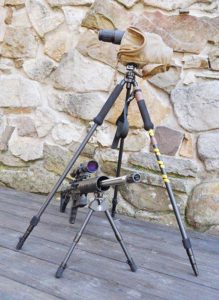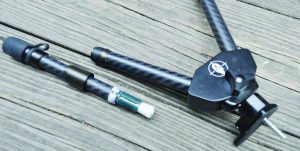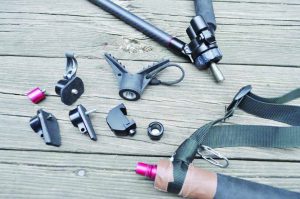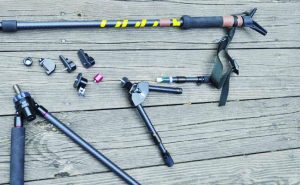by John Markwell | Contributing Editor

The Javalin bipod mounted on an Alexander Arms AAR17 HMR with the pic rail adapter and the Kapita tripod with Leupold Spotter in place. All of the tripod’s legs are removable from the swivel head and the two with foam hand grips do double duty as trekking poles. Author-modified pole/leg is the one with the yellow tape and the rubber foot-cap removed.
We are always on the lookout for new bipods. However, many bipods on the market today are heavy, bulky, complicated and just plain “clunky”; same goes for tripods for supporting optics. At SHOT 2016 (or was it NRA?) we ran across a British firm, Spartan Precision Equipment, (sales@javalinbipods.com), that had some of the neatest bipods and tripods we’d seen in quite a while. Using space-age materials—carbon fiber, aluminum and magnets (yes magnets)—Spartan Precision engineers have revolutionized the rifle/optics support market with their Javalin Bipod and Kapita tripod.
We obtained a sample Javalin bipod at the show and used it throughout the Summer of 2016 shooting prairie dogs out West in May and June and woodchuck back East during the rest of the summer. Made from ultra-light and strong carbon fiber and 7075 aluminum the Javalin is much tougher than it first appears to be and weighs in at just a hair over 5 oz. We found the function of the Javalin to be superb, even when shooting prone in the dust and dirt of the prairie dog towns. Unlike metal-legged bipods, the carbon fiber legs of the Javalin stayed “slick” and easily adjustable throughout several days of ‘doggin’.

The Javalin bipod with the flat stock adapter in place with the magnetic wood screw for mounting in the forend of a wood-stocked rifle. Also shown is the internal expansion mechanism that holds the leg solidly when adjusted for height.
Attachment to rifles is simple using one of the universal adapters that replace the front sling swivel stud on the rifle’s stock; the bipod just snaps in and is held in place by the strong N52 Neodymium rare earth magnet in the top stud. This stud is also cant adjustable and is secured in position with a friction lock. The use of multiple adapters on several rifles allows for quick and painless switching of the bipod from one rifle to another. There is even an adapter designed to be inletted into the forearm of a rifle stock, providing a low-profile flush socket for the bipod to plug into. Leg adjustment for height is accomplished by turning the bipod’s legs clockwise to unlock them and reversing that to re-lock the legs when extended to the desired length. The internal friction lock used is the same as that used in adjustable trekking and ski poles (more on that later). The carbon fiber legs are tipped with Tungsten Carbide for use on rock and ice and are capped with removable rubber feet. The true beauty of the Javelin bipod is two-fold: light weight and easy on/off. The Javalin can be easily pocket-carried and snapped in place in an instant for use. Although adjustable from 6.5-9.5 inches, we found that one leg height adjustment (about 8”) worked well for most of the terrain in which we used the bipod. There is also a tall model 8.5-13”. This is a high-quality bipod with materials and workmanship second to none. With an assortment of stock adapters and a carrying case the Javalin has a retail price of $249

A close up of the Kapita tripod’s ball head and the top of the leg/trekking pole. To the left of the U adapter (with P-cord keeper loop) are the two optics mounts and below these are the four stock mounting adapters. Note the small ‘biner in the wrist strap for attaching the U adapter when it’s not mounted atop the leg/trekking pole or on the tripods ball mount.
As mentioned above, the Spartan Javalin Bipod uses ski/trekking pole technology in achieving its lightweight and strength. So, it is only logical that the company offers trekking poles; but with a twist. The Kapita is a Tripod, Bipod, Monopod, and a pair of Trekking poles all in one unit. Usable while sitting or standing, the system can be used with 1, 2 or 3 legs as they are all removable from the head and interchangeable. The head of the Kapita has a magnetic ball which interfaces with any of the same adapters used with the Javalin Bipod as well as two different optics mounts for cameras, binoculars or a spotting scope. There is also a handy Woodland U adapter for use on the tripod or atop one of the trekking poles. Each leg has a magnet in the top and can be used as a monopod, again with any of the stock or optics adapters. Two of the removable legs also have foam hand grips at the top for use as trekking poles. To say that this is a versatile piece of gear is an understatement.
We have always found using a trekking pole (we used to call them a walking stick) to be highly advantageous in rough country. In fact, we have used cast off ski poles for a third leg for many years. We took one of the foam-gripped tripod legs and made some minor modifications to it in order to better fill its role as a trekking pole. First, we added some yellow tape stripes to the upper part of the pole so we could see it when laid aside as an aid to not inadvertently leaving it behind. Secondly, we rigged a nylon wrist loop to the top of the foam grip. Since we planned on using the U adapter on top of the leg when in trekking pole mode (great for offhand shooting support with either rifle or handgun), we needed a way to keep track of it when the leg was in tripod mode. So, we simply burned a small hole in the nylon strap to accept a small “S” carabiner and put a short P-cord loop on the U adapter for clipping it to the wrist loop. That way the Woodland U adapter is always with the designated trekking pole leg. The internal friction/expansion lock system used in the Kapita’s (and the Javalin Bipod’s) legs is proven technology. When torqued snug the units will take quite a bit of weight and the carbon fiber legs will not snap or bend.

In this photo the trekking pole has the U adapter in place atop the grip. The accessories grouped to the left are the four different bipod mounts and the two optics mounts. All the different adapters are usable on the tripod, trekking pole/leg and bipod. A bit of imagination goes a long way in utilizing these field supports.
We first used the Kapita in tripod mode out on the mountain in March during a long-range shooting session. We mounted our Leupold spotter atop the Magnetic ball head using the Heavy Optics adapter. Made from 7075 aluminum, with a really neat and compact clamp, the Heavy Optics adapter worked better than we thought it would, considering its diminutive size. Perched atop the magnetic post of the ball head, the spotting scope was easy to get on target and stayed there when the locking collar was tightened down. The locking collar, by the way, is so finely finished and anodized that we found it to be quite slick, so we later gave it a light coat of airplane wing-walk paint in order to get a better grip when tightening it. The Kapita was stable in the wind, even when extended to about 5 feet; tall enough for use when sitting on the tailgate of the pickup. However, the ball head doesn’t totally stabilize unless the tripod’s legs are fully loaded outwardly.
Weighing in at 22 oz., the Kapita is easily toted by hand or in a pack. Deployment and adjustment of the legs is simple, even on uneven ground. We are just beginning to appreciate the versatility of the Kapita as a support system in the field. Use with firearms or optics is simple using the available adapters and we find the trekking pole feature to be a valuable bonus. High tech is not cheap and the $500+ price tag of the Kapita reflects not only the quality of the materials used by the folks at Spartan Precision but also the innovative application of modern technology and ideas to upgrade and make a common item a leader in the field. For the mountain hunter looking for a multi-use item that offers great weight savings or for those looking to buy a versatile high tech field support system, The Spartan Precision Kapita may be the last word in tripods. Good shooting!



